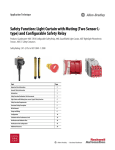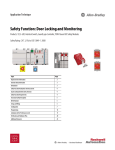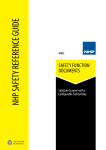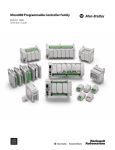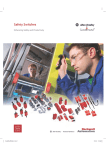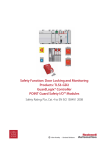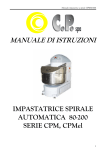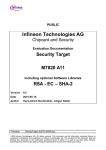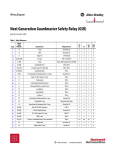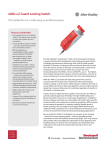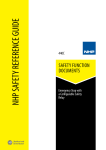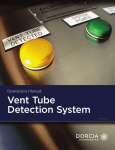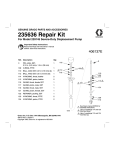Download Safety Function: Door-Monitoring Interlock Switch
Transcript
Application Technique Safety Function: Door-Monitoring Interlock Switch with a Configurable Safety Relay Products: SensaGuard Switch, Guardmaster 440C-CR30 Configurable Safety Relay, 100S-C Safety Contactors Safety Rating: CAT. 4, PLe to ISO 13849-1: 2008 Topic Page Important User Information 2 General Safety Information 3 Introduction 3 Safety Function Realization: Risk Assessment 3 Safety-Related Stop Safety Function 4 Safety Function Requirements 4 Functional Safety Description 4 Bill of Material 5 Setup and Wiring 5 Configuration 8 Calculation of the Performance Level 21 Verification and Validation Plan 23 Verification of the Configuration 27 Additional Resources 30 Safety Function: Door-Monitoring Interlock Switch with a Configurable Safety Relay Important User Information Read this document and the documents listed in the additional resources section about installation, configuration, and operation of this equipment before you install, configure, operate, or maintain this product. Users are required to familiarize themselves with installation and wiring instructions in addition to requirements of all applicable codes, laws, and standards. Activities including installation, adjustments, putting into service, use, assembly, disassembly, and maintenance are required to be carried out by suitably trained personnel in accordance with applicable code of practice. If this equipment is used in a manner not specified by the manufacturer, the protection provided by the equipment may be impaired. In no event will Rockwell Automation, Inc. be responsible or liable for indirect or consequential damages resulting from the use or application of this equipment. The examples and diagrams in this manual are included solely for illustrative purposes. Because of the many variables and requirements associated with any particular installation, Rockwell Automation, Inc. cannot assume responsibility or liability for actual use based on the examples and diagrams. No patent liability is assumed by Rockwell Automation, Inc. with respect to use of information, circuits, equipment, or software described in this manual. Reproduction of the contents of this manual, in whole or in part, without written permission of Rockwell Automation, Inc., is prohibited. Throughout this manual, when necessary, we use notes to make you aware of safety considerations. WARNING: Identifies information about practices or circumstances that can cause an explosion in a hazardous environment, which may lead to personal injury or death, property damage, or economic loss. ATTENTION: Identifies information about practices or circumstances that can lead to personal injury or death, property damage, or economic loss. Attentions help you identify a hazard, avoid a hazard, and recognize the consequence. IMPORTANT Identifies information that is critical for successful application and understanding of the product. Labels may also be on or inside the equipment to provide specific precautions. SHOCK HAZARD: Labels may be on or inside the equipment, for example, a drive or motor, to alert people that dangerous voltage may be present. BURN HAZARD: Labels may be on or inside the equipment, for example, a drive or motor, to alert people that surfaces may reach dangerous temperatures. ARC FLASH HAZARD: Labels may be on or inside the equipment, for example, a motor control center, to alert people to potential Arc Flash. Arc Flash will cause severe injury or death. Wear proper Personal Protective Equipment (PPE). Follow ALL Regulatory requirements for safe work practices and for Personal Protective Equipment (PPE). 2 Rockwell Automation Publication SAFETY-AT133C-EN-P - October 2015 Safety Function: Door-Monitoring Interlock Switch with a Configurable Safety Relay General Safety Information Contact Rockwell Automation to find out more about our safety risk assessment services. IMPORTANT This application example is for advanced users and assumes that you are trained and experienced in safety system requirements. ATTENTION: Perform a risk assessment to make sure all task and hazard combinations have been identified and addressed. The risk assessment can require additional circuitry to reduce the risk to a tolerable level. Safety circuits must take into consideration safety distance calculations, which are not part of the scope of this document. Introduction This safety function application example explains how to wire and configure a Guardmaster® 440C-CR30 configurable safety relay to monitor a SensaGuard™ non-contact interlock switch. The SensaGuard-monitored door allows partial body access to the guarded area. When that door is opened while the motor is running , or a fault is detected in the monitoring circuit, the 440C-CR30 configurable safety relay de-energizes the two 100S contactors, removing power from the motor. The hazardous motion coasts to a stop. Safety Function Realization: Risk Assessment The required performance level is the result of a risk assessment and refers to the amount of the risk reduction to be carried out by the safety-related parts of the control system. Part of the risk reduction process is to determine the safety functions of the machine. In this application, the performance level required (PLr) by the risk assessment is Category 3, Performance Level d (CAT. 3, PLd), for each safety function. A safety system that achieves CAT. 3, PLd, or higher, can be considered control reliable. Each safety product has its own rating and can be combined to create a safety function that meets or exceeds the PLr. From: Risk Assessment (ISO 12100) 1. Identification of safety functions 2. Specification of characteristics of each function 3. Determination of required PL (PLr) for each safety function To: Realization and PL Evaluation Rockwell Automation Publication SAFETY-AT133C-EN-P - October 2015 3 Safety Function: Door-Monitoring Interlock Switch with a Configurable Safety Relay Safety-Related Stop Safety Function This application includes one safety function: Safety-related stop initiated by a SensaGuard switch. Safety Function Requirements Opening the door trips the SensaGuard switch and stops the hazardous motion by removing power to the motor. The hazardous motion coasts to a stop. Once the door is closed and the 440C-CR30 configurable safety relay is reset, power is not restored to the motor until the motor is given an external Start command (a deliberate second action). Faults at the SensaGuard switch, wiring terminals, 440C-CR30 configurable safety relay, or 100S contactors are detected before the next safety demand. This circuit can connect to and interrupt power to motors rated up to 12A, 600V AC. Personnel must not be able to open the door and reach the hazardous motion before it has stopped. The nearest hazard is a 32-inch reach from the door. Testing has shown that the quickest time between the start of a person opening the door and that person reaching the nearest hazard is 1.5 seconds. Calculations, based on the worst-case stopping time, must be done to be certain that the safety system does not permit a person to open the door and reach a moving hazard. Testing has shown that the worst-case coast-to-stop time is 500 ms. The total worst-case hazardous motion stop time can be calculated as follows: Activity Time (in milliseconds) SensaGuard switch response (OFF) time 54 440C-CR30 configurable safety relay response (OFF) time 45 100S contactor response (OFF) time 20 Worst-case coast-to-stop time 500 Total worst-case hazardous motion stop time 619 This system fulfills the requirement of assuring that a person cannot reach the nearest hazard while that hazard is moving. If it is not possible to stop the machine in time (500 ms is quite large), then the designer must use a guard locking switch, for example the new 440G-LZ, and allow access to the machine only when it has stopped and there are no hazards. The safety function in this application technique meets or exceeds the requirements for Category 3, Performance Level d (CAT. 3, PLd), per ISO 13849-1 and control reliable operation per ANSI B11.19. Functional Safety Description Personnel are protected from the hazardous motion by a fixed barrier. Access to the hazardous area, when necessary, is through a swinging door. The door is monitored by a SensaGuard non-contact interlock, which is connected to inputs of the 440C-CR30 configurable safety relay. The 440C-CR30 relay controls two 100S-C safety contactors which, connected in a series, control power to the motor that drives the hazardous motion. Whenever this monitored door is opened, the safety system removes power to the motor. The motor and the hazardous motion it drives coast to a stop (Stop Category 0). The motor cannot be restarted while the monitored door is open. Once 4 Rockwell Automation Publication SAFETY-AT133C-EN-P - October 2015 Safety Function: Door-Monitoring Interlock Switch with a Configurable Safety Relay the door is closed, the motor can be restarted by pressing and releasing the Reset button to reset the 440C-CR30 relay and then initiating the external Start to restore the motor power that is controlled by the 100S-C contactors. The SensaGuard switch monitors the status (open or closed) of the door. The SensaGuard switch also monitors its two OSSD outputs for faults. The 440C-CR30 relay monitors the inputs from the SensaGuard switch for faults, and it also monitors the status of the Reset and Feedback signals from the 100S-C contactors. The relay monitors its own outputs for faults as well. These outputs control the 100S-C contactors. The 440C-CR30 relay turns off its outputs and removes power to the motor when a fault is detected. It does not reset until that fault is corrected. Bill of Material This application uses these products. Cat. No. Description Qty 440N-Z21S16B SensaGuard switch, 18 mm plastic, 2 x PNP, 0.2A max., safety output, 10 m cable 1 800FP-R611 800F reset, round plastic (type 4/4X/13, IP66), blue, R , standard pack 1 2080-IQ4OB4 4-channel digital input/output combination module 1 1761-CBL-PM02 Cable; 440C-CR30 configurable safety relay to personal computer, printer cable 1 440C-CR30-22BBB Guardmaster 440C-CR30 software configured safety relay, PLe SIL 3, 22 safety I/O, embedded serial port, USB programming port, 2 plug-in slots, 24.0V DC 1 100S-C23EJ23BC MCS 100S-C safety contactor, 23A, 24V DC (with electric coil), bifurcated contact 2 Setup and Wiring For detailed information on installing and wiring, refer to the publications listed in the Additional Resources on the back cover. System Overview The SensaGuard interlock switch is used to confirm that the guarded door is in the safe, closed condition. Hazardous motion is ceased or prevented whenever this door is not closed. In addition to monitoring the state of the guarded door, the SensaGuard switch monitors its outputs for all fault conditions. The 440C-CR30 configurable safety relay also detects an open-wire fault, a single-channel fault, or a short to 0V at its SensaGuard switch inputs. The 440C-CR30 configurable safety relay monitors the pulse-tested outputs that drive the safety contactor coils for all fault conditions. The proper, safe state of the safety contactors, K1 and K2, is confirmed by the 440C-CR30 configurable safety relay that is monitoring the feedback signals at SMF2 at start-up. Rockwell Automation Publication SAFETY-AT133C-EN-P - October 2015 5 Safety Function: Door-Monitoring Interlock Switch with a Configurable Safety Relay Electrical Schematic DC Com 24V DC - Class 2 440C-CR30-22BBB A1 A2 440C-CR30 Configurable Safety Relay Bn Rd Yel Access Door Gy Pk 440N-Z21U16A EI_00 EO_18 EI_01 EO_19 Bu 2080-IQ4OB4 Feedback K1 P1_00 Plug-In I/O K2 P1_01 Reset 800FP-R611PQ10V 6 P1_02 A3 B4 B3 Rockwell Automation Publication SAFETY-AT133C-EN-P - October 2015 Safety Function: Door-Monitoring Interlock Switch with a Configurable Safety Relay DC Com 24V DC - Class 2 440C-CR30-22BBB A1 A2 440C-CR30 Configurable Safety Relay 100S-C23EJ23BC* EI_00 EO_18 EI_01 EO_19 K1 100S-C23EJ23BC* K2 L1 L2 L3 External Start Stop K1 K2 M 2080-IQ4OB4 P1_00 P1_01 Plug-In I/O P1_02 A3 B4 B3 *ISO 13849-2 requires transient suppression across the load as a Basic Safety Principal. The 'EJ' electronic coil provides suitable suppression. Rockwell Automation Publication SAFETY-AT133C-EN-P - October 2015 7 Safety Function: Door-Monitoring Interlock Switch with a Configurable Safety Relay Configuration The 440C-CR30 relay is configured by using Connected Components Workbench™ software, release 6.01 or later. A detailed description of each step is beyond the scope of this document. Knowledge of the Connected Components Workbench software is assumed. Configure the 440C-CR30 Relay Follow these steps to configure the Guardmaster 440C-CR30 relay in Connected Components Workbench software. 1. In Connected Components Workbench software, choose View and then Device Toolbox. 2. Select 440C-CR30-22BBB. 8 Rockwell Automation Publication SAFETY-AT133C-EN-P - October 2015 Safety Function: Door-Monitoring Interlock Switch with a Configurable Safety Relay 3. In the Project Organizer, double-click Guardmaster_400C_CR30 *. 4. To add the plug-in I/O module called for in this circuit, right-click the left plug-in module space and choose the 2080-IQ4OB4 module. TIP The I/O module is shown in standard gray, because it is not a safety I/O module. That is permissible in this application, because it is not used to connect safety signals. Inputs such as Feedback and Reset button are not considered strict, safety signals. Using the standard I/O for these non-safety signals can reserve the limited number of safety inputs and outputs for true safety signals. Rockwell Automation Publication SAFETY-AT133C-EN-P - October 2015 9 Safety Function: Door-Monitoring Interlock Switch with a Configurable Safety Relay 5. Click the Edit Logic button to open the Connected Components Workbench Workspace. A blank workspace appears. 6. From the View pull-down menu, choose Toolbox. 10 Rockwell Automation Publication SAFETY-AT133C-EN-P - October 2015 Safety Function: Door-Monitoring Interlock Switch with a Configurable Safety Relay The Toolbox appears. Configure the Inputs The Toolbox does not list a SensaGuard Safety Monitoring Function. Follow these steps to configure one. 1. Select Alternative Device. 2. Drag it to the green block in the Safety Monitoring column and release it. Connected Components Workbench software automatically assigns the first two available inputs, EI_00 and EI_01, to the device. Leave those as assigned. Connected Components Workbench software automatically assigns the function name SMF 1 to this block. By default, the software assumes an electro-mechanical device and assigns Test Sources. The SensaGuard switch has two OSSD outputs and does not require Test Sources. Rockwell Automation Publication SAFETY-AT133C-EN-P - October 2015 11 Safety Function: Door-Monitoring Interlock Switch with a Configurable Safety Relay 3. To properly configure the block, open Advanced Settings and select 2 OSSD from the Inputs pull-down menu. The resulting block appears as shown. 4. Click, drag , and release a Feedback Monitoring Safety Monitoring function to the Safety Monitoring block below the SensaGuard block in the Workspace. 12 Rockwell Automation Publication SAFETY-AT133C-EN-P - October 2015 Safety Function: Door-Monitoring Interlock Switch with a Configurable Safety Relay Note that Connected Components Workbench software assigns this to input terminal EI_02, the next available Safety Input terminal. The software assumes that this is a single input and automatically assigns the function name SMF 2 to this block. 5. Because the circuit requires two inputs, one from each contactor, change the number of inputs to 2, one for the N.C. contact from each 100S contactor. 6. Assign the inputs to Plug-In terminals PI_00 and PI_01. This avoids unnecessarily using Safety Inputs for feedback signals. Rockwell Automation Publication SAFETY-AT133C-EN-P - October 2015 13 Safety Function: Door-Monitoring Interlock Switch with a Configurable Safety Relay 7. Click, drag , and release a Reset safety monitoring function to the Safety Monitoring block below the Feedback Monitoring block in the Workspace. Connected Components Workbench software automatically assigns the function name SMF 3 to this block. 8. Reassign the Reset Input to Plug-In terminal PI_02. Configure the Outputs Follow these steps to configure the outputs. 1. Click and drag Immediate OFF from the Safety Output Function Blocks section of the Toolbox. 2. Release it on the top block of the Safety Output column in the Workspace. 14 Rockwell Automation Publication SAFETY-AT133C-EN-P - October 2015 Safety Function: Door-Monitoring Interlock Switch with a Configurable Safety Relay Connected Components Workbench software automatically assigns output terminals EO_18 and EO_19. Pulse Testing is the default for these terminals. The default Reset Type is Manual. Leave these settings at their defaults. 3. Choose SMF 2 from the Feedback pull-down menu. 4. Choose SMF 3 from the Reset Input pull-down menu. The safety output configuration is complete. Configure the Logic The Logic section determines how the safety outputs respond to the safety monitoring inputs. In this case, the safety output follows the safety monitoring input directly. 1. Click the blue dot on the right side of the SensaGuard Safety Monitoring input block. It turns gray. Rockwell Automation Publication SAFETY-AT133C-EN-P - October 2015 15 Safety Function: Door-Monitoring Interlock Switch with a Configurable Safety Relay 2. Click the blue dot on the left side of the Safety Output block to connect the logic. The completed logic looks like this. Configure the Status Indicators The 440C-CR30 configurable safety relay provides ten user-configurable input status indicator LEDs and six userconfigurable output status indicator LEDs. In many cases, they can be very helpful in installing , commissioning , monitoring , and troubleshooting a 440C-CR30 configurable safety relay system. They do not affect the operation of the system in any way, and it is not necessary to configure them, but they are easy to configure and it is a recommended practice to use them. 16 Rockwell Automation Publication SAFETY-AT133C-EN-P - October 2015 Safety Function: Door-Monitoring Interlock Switch with a Configurable Safety Relay 1. Click Guardmaster_440C_CR30*. 2. Select LED Configuration. 3. For the Type Filter, choose Terminal Status for LED 0. 4. For LED 0, choose Terminal 00 from the Value pull-down menu. Rockwell Automation Publication SAFETY-AT133C-EN-P - October 2015 17 Safety Function: Door-Monitoring Interlock Switch with a Configurable Safety Relay The Status Indicator LED 0 is now configured to show the status of terminal 00. 5. Assign the next four Input LEDs (1…4) in the same manner. SensaGuard OSSD 1 Status SensaGuard OSSD 2 Status SensaGuard Status Feedback Status Reset Status The input status indicator LEDs are now configured. 6. Assign the three output LEDs as follows. Output Channel 1 Status Output Channel 2 Status Safety Output Status 18 Rockwell Automation Publication SAFETY-AT133C-EN-P - October 2015 Safety Function: Door-Monitoring Interlock Switch with a Configurable Safety Relay Confirm the Validity of the Build Follow these steps to confirm the validity of the logic by using the Build feature in Connected Components Workbench software. 1. Click Guardmaster_440C_CR30 in the bar above the Workspace. 2. Click Build. A Build Succeeded message confirms that the configuration is valid. If an error or omission is discovered during a build, a message is displayed which details the error so that it may be corrected. After you correct the error, you need to perform the build again. Save and Download the Project Follow these steps to save and download the project. 1. From the File menu, choose Save as to save the project. IMPORTANT Saving the project with a new name closes the workspace window(s). 2. In the Project Organizer window, double click Guardmaster_440C_CR30 to open the workspace. 3. Power up the 440C-CR30 safety relay. 4. Connect the USB cable to the 440C-CR30 relay. Rockwell Automation Publication SAFETY-AT133C-EN-P - October 2015 19 Safety Function: Door-Monitoring Interlock Switch with a Configurable Safety Relay 5. Click Download. 6. In the Connection Browser, expand the AB_VBP-1 Virtual Chassis and select the Guardmaster 440C-CR3022BBB. 7. Click OK. 8. Click Yes to change from Run to Program mode. 9. When the download is complete, click Yes to change from Program to Run mode. 20 Rockwell Automation Publication SAFETY-AT133C-EN-P - October 2015 Safety Function: Door-Monitoring Interlock Switch with a Configurable Safety Relay 10. Click Edit Logic to see the online diagnostics. Green indicates that a block is True or that an input or output terminal is ON. Flashing green indicates that a Safety Output Function is ready to be Reset. The online diagnostics mode of the 440C-CR30 relay can be very helpful during the verification process. 11. Review the information in Calculation of the Performance Level on page 21 and Verification and Validation Plan on page 23 before proceeding with Verification of the Configuration on page 27. Calculation of the Performance Level When properly implemented, this safety-related stop function can achieve a safety rating of Category 4, Performance Level e (CAT. 4, PLe), according to ISO 13849-1: 2008, as calculated by using the SISTEMA software PL calculation tool. The minimum Performance Level required (PLr) from the risk assessment for this safety function is PLd. Rockwell Automation Publication SAFETY-AT133C-EN-P - October 2015 21 Safety Function: Door-Monitoring Interlock Switch with a Configurable Safety Relay This safety-related stop initiated by a safeguard safety function can be modeled as follows: Input Output Logic 100S K1 SensaGuard Switch 440C-CR30 Relay 100S K2 Subsystem 1 Subsystem 2 Subsystem 3 Because these are electro-mechanical devices, the safety contactors data includes the following : • Mean Time to Failure, dangerous (MTTFd) • Diagnostic Coverage (DCavg ) • Common Cause Failure (CCF) Electro-mechanical devices' functional safety evaluations include the following: • How frequently they are operated • Whether they are effectively monitored for faults • Whether they are properly specified and installed SISTEMA calculates the MTTFd by using B10d data provided for the contactors, along with the estimated frequency of use, entered during the creation of the SISTEMA project. The DCavg (99%) for the contactors is selected from the Output Device table of ISO 13849-1 Annex E, Direct Monitoring. The CCF value is generated by using the scoring process outlined in Annex F of ISO 13849-1. The complete CCF scoring process must be performed when actually implementing an application. A minimum score of 65 must be achieved. 22 Rockwell Automation Publication SAFETY-AT133C-EN-P - October 2015 Safety Function: Door-Monitoring Interlock Switch with a Configurable Safety Relay Verification and Validation Plan Verification and validation play important roles in the avoidance of faults throughout the safety system design and development process. ISO 13849-2 sets the requirements for verification and validation. The standard calls for a documented plan to confirm that all of the safety functional requirements have been met. Verification is an analysis of the resulting safety control system. The Performance Level (PL) of the safety control system is calculated to confirm that the system meets the required Performance Level (PLr) specified. The SISTEMA software is typically used to perform the calculations and assist with satisfying the requirements of ISO 13849-1. Validation is a functional test of the safety control system to demonstrate that the system meets the specified requirements of the safety function. The safety control system is tested to confirm that all of the safety-related outputs respond appropriately to their corresponding safety-related inputs. The functional test includes normal operating conditions in addition to potential fault injection of failure modes. A checklist is typically used to document the validation of the safety control system. Prior to validating the system, confirm that the Guardmaster 440C-CR30 configurable safety relay has been wired and configured in accordance with the installation instructions. Verification and Validation Checklist General Machinery Information Machine Name/Model Number Machine Serial Number Customer Name Test Date Tester Names Schematic Drawing Number Input Devices 440N-Z21S16B Configurable Safety Relay 440C-CR30-22BBB Variable Frequency Drive Safety Contactor 100S-C23EJ23BC Safety Wiring and Relay Configuration Test Step Verification 1 Confirm that all components' specifications are suitable for the application. Refer to Basic Safety Principles and Well-tried Safety Principles from ISO 13849-2. Pass/Fail 2 Visually inspect the safety relay circuit to confirm that it is wired as documented in the schematics. 3 Confirm that the configuration in the 440C-CR30 configurable safety relay is the correct, intended configuration. Changes/Modifications Normal Operation Verification - The safety system properly responds to all normal Start, Stop, Reset, E-stop and SensaGuard switch inputs. Test Step Verification Pass/Fail 1 Confirm that no one is in the guarded area. 2 Confirm that the hazardous motion is stopped. 3 Confirm that the door is closed. Rockwell Automation Publication SAFETY-AT133C-EN-P - October 2015 Changes/Modifications 23 Safety Function: Door-Monitoring Interlock Switch with a Configurable Safety Relay 4 Apply power to the safety system. 5 Confirm that the Terminal 00, Terminal 01, and SMF1 input status indicator LEDs of the 440C-CR30 safety relay are green. Confirm that all output status indicators are OFF. Confirm that the Power and Run status indicator LEDs are green. Monitor the 440CCR30 safety relay for proper status by using Connected Components Workbench software. 6 Press and release the Reset button on the 440C-CR30 safety relay. Confirm that the Terminal 18, Terminal 19, and SOF1 output status indicator LEDs are green. Monitor the status indicator LEDs for proper operation, and monitor the 440C-CR30 safety relay for proper status by using Connected Components Workbench software. 7 Confirm that the hazardous motion does not start on powerup. 8 Press and release the drive Start button. Confirm that the hazardous motion begins and that the machine begins to operate. 9 Press the external Stop button. The machine must stop in its normal, configured manner. The safety system must not respond. 10 Press and release the external Start button. Confirm that the hazardous motion starts and the machine begins to operate. 11 Open the guarded door. The safety system must trip. The hazardous motion must stop within less than 0.7 seconds. Monitor the status indicator LEDs for proper operation and monitor the 440C-CR30 safety relay for proper status by using Connected Components Workbench software. 12 Press and release the Reset button on the 440C-CR30 safety relay. The 440C-CR30 configurable safety relay must not respond. Monitor the status indicator LEDs for proper operation, and monitor the 440C-CR30 safety relay for proper status by using Connected Components Workbench software 13 Close the guarded door. The machine must not start. The 440C-CR30 safety relay must not respond. Monitor the status indicator LEDs for proper operation, and monitor the 440C-CR30 safety relay for proper status by using Connected Components Workbench software. 14 Press and release the Reset button on the 440C-CR30 safety relay. The SOF1 of the 440CCR30 safety relay must energize. The hazardous motion must not start. Monitor the status indicator LEDs for proper operation, and monitor the 440C-CR30 safety relay for proper status by using Connected Components Workbench software. 15 Press and release the external Start button. Confirm that the motor starts and that the machine begins to operate. Validation of Safe Response to Abnormal Operation - The safety system responds properly to all foreseeable faults with corresponding diagnostics. SensaGuard and 440C-CR30 Configurable Safety Relay Tests Test Step Verification and Validation 1 Keep the guarded door closed. While the hazardous motion continues to run. remove the SensaGuard OSSD1 wire to terminal EI_00 of the 440C-CR30 safety relay. The 440CCR30 safety relay must trip immediately. The red Fault status indicator LED on the relay must blink. Monitor all status indicator LEDs for proper operation and monitor the 440C-CR30 safety relay for proper status by using Connected Components Workbench software. 2 Reconnect the wire to E1_00. The 440C-CR30 safety relay must not respond. Press and release the Reset button on the 440C-CR30 safety relay. The 440C-CR30 safety relay must not respond. Monitor all status indicator LEDs for proper operation and monitor the 440C- CR30 safety relay for proper status by using Connected Components Workbench software. 3 Open and close the guarded door. The red Fault status LED must be OFF. Monitor all status indicator LEDs for proper operation, and monitor the 440C-CR30 safety relay for proper status by using Connected Components Workbench software. 24 Pass/Fail Rockwell Automation Publication SAFETY-AT133C-EN-P - October 2015 Changes/Modifications Safety Function: Door-Monitoring Interlock Switch with a Configurable Safety Relay 4 Press and release the Reset button on the 440C-CR30 safety relay. The SOF 1 output on the 440C-CR30 relay must energize. Monitor all status indicator LEDs for proper operation, and monitor the 440C-CR30 safety relay for proper status by using Connected Components Workbench software. 5 Press the external Start button. The machine must start to run. Monitor all status indicator LEDs for proper operation, and monitor the 440C-CR30 safety relay for proper status by using Connected Components Workbench software.This step is optional in the following SensaGuard validation tests (Steps 6 through 27). 6 With the guarded door closed, connect OSSD 1 to 24V DC. After approximately 40 seconds, the SensaGuard switch trips. The 440C-CR30 safety relay trips. The red Fault status indicator LED on the 440C-CR30 safety relay must blink. The status indicator on the SensaGuard switch flashes red. Monitor all status indicator LEDs for proper operation, and monitor the 440C-CR30 safety relay for proper status by using Connected Components Workbench software. 7 Disconnect OSSD 1 from 24V DC. Neither the SensaGuard switch nor the 440C-CR30 safety relay respond. Press and release the Restart button on the 440C-CR30 safety relay. Neither the SensaGuard switch nor the 440C-CR30 safety relay respond. Monitor all status indicator LEDs for proper operation, and monitor the 440C-CR30 safety relay for proper status by using Connected Components Workbench software. 8 Cycle power to the SensaGuard switch. Approximately five seconds after power is restored to the SensaGuard switch, its status LED turns steady green. The blinking red Fault status indicator LED on the 440C-CR30 safety relay turns OFF. Monitor all status indicator LEDs for proper operation, and monitor the 440C-CR30 safety relay for proper status by using Connected Components Workbench software. 9 Press and release the Reset button on the 440C-CR30 safety relay. Monitor all status indicator LEDs for proper operation, and monitor the 440C-CR30 safety relay for proper status by using Connected Components Workbench software. 10 Connect OSSD 1 to DC COM. The 440C-CR30 safety relay trips immediately. The red Safe Stop stack light turns ON. The amber Gate 1 stack light turns ON. The red Fault status indicator LED on the 440C-CR30 safety relay must blink. The status indicator on the SensaGuard switch flashes red. 11 Disconnect OSSD1 from DC COM. Neither the SensaGuard switch nor the 440C-CR30 safety relay respond. Press and release the Restart button on the 440C-CR30 safety relay. Neither the SensaGuard switch nor the 440C-CR30 safety relay respond. 12 Cycle power to the SensaGuard switch. Approximately five seconds after power is restored to the SensaGuard switch, its status indicator LED lights steady green. The amber Gate 1 stack light turns OFF. The red Safe Off stack light remains ON. The blinking red Fault status indicator LED on the 440C-CR30 safety relay turns OFF. 13 Press and release the Reset button on the 440C-CR30 safety relay. The 440C-CR30 safety relay's SOF 1 must energize the contactors. Monitor all status indicator LEDs for proper operation, and monitor the 440C-CR30 safety relay for proper status by using Connected Components Workbench software. 14 to 27 Repeat steps 1 through 13 using EI_01 in place of EI_00, and OSSD 2 in place of OSSD 1. 28 Connect OSSD 1 to OSSD 2 (terminal EI_00 to terminal EI_01). After approximately 50 seconds, the SensaGuard switch trips. The 440C-CR30 safety relay trips. The status indicator on the SensaGuard switch flashes red. Monitor all status indicator LEDs for proper operation, and monitor the 440C-CR30 safety relay for proper status by using Connected Components Workbench software. 29 Disconnect OSSD 1 from OSSD 2. Neither the SensaGuard switch nor the 440C-CR30 safety relay respond. Press and release the Restart button on the 440C-CR30 safety relay. Neither the SensaGuard switch nor the 440C-CR30 safety relay respond. 30 Cycle power to the SensaGuard switch. Approximately five seconds after power is restored to the SensaGuard switch, its status LED turns steady green. The blinking red Fault status indicator LED on the 440C-CR30 safety relay turns OFF. Monitor all status indicator LEDs for proper operation, and monitor the 440C-CR30 safety relay for proper status by using Connected Components Workbench software. Rockwell Automation Publication SAFETY-AT133C-EN-P - October 2015 25 Safety Function: Door-Monitoring Interlock Switch with a Configurable Safety Relay 31 Press and release the Reset button on the 440C-CR30 safety relay. The red Safe Stop stack light must be OFF. The SOF1 output on the 440C-CR30 safety relay must energize the contactors. Monitor all status indicator LEDs for proper operation, and monitor the 440C-CR30 safety relay for proper status by using Connected Components Workbench software. Validation of Safe Response to Abnormal Operation - The safety system responds properly to all foreseeable faults with corresponding diagnostics. Contactor - 440C-CR30 Configurable Safety Relay Tests Test Step Verification and Validation Pass/Fail 1 While the machine continues to run, break the connection between terminal EO_18 of the 440C-CR30 configurable safety relay and the A1 terminal of the K1 coil. The hazardous motion must coast to a stop. 2 Press the external Stop button. Restore the connection. Press the external Start button to resume the hazardous motion. 3 While the hazardous motion continues to run, connect the A1 terminal of the K1 coil to 24V DC. After approximately 18 seconds, the 440C-CR30 safety relay must trip. K2 must de-energize. The hazardous motion coasts to a stop. The red Fault status indicator LED on the 440C-CR30 safety relay is ON. 4 Disconnect the A1 terminal of the K1 coil from 24V DC. Press and release the Reset button on the 440C-CR30 safety relay. The 440C-CR30 safety relay must not respond. 5 Cycle power to the 440C-CR30 safety relay. It responds. The 440C-CR30 safety relay Fault status indicator LED is OFF. 6 Press and release the Reset button on the 440C-CR30 safety relay. Press the external Start button. The hazardous motion must resume. 7 While the machine continues to run, short the A1 terminal of the K1 coil to DC COM. The 440C- CR30 safety relay must trip. The red Fault status indicator LED on the 440C-CR30 safety relay is ON. 8 Disconnect the A1 terminal of the K1 coil from DC COM. Press and release the Reset button on the 440C-CR30 safety relay. The 440C-CR30 safety relay must not respond. 9 Cycle power to the 440C-CR30 safety relay. The 440C-CR30 safety relay responds. The Fault status indicator LED on the 440C-CR30 safety relay is OFF. 10 Press and release the Reset button on the 440C-CR30 safety relay. Press the external Start button. The hazardous motion resumes. 11 to 21 Repeat steps 1 to 10 using EO_19 in place of EO_18, and K2 in place of K1. 22 Connect the A1 terminal of K1 to the A1 terminal of K2. After approximately 18 seconds, the 440C-CR30 safety relay must trip. The hazardous motion coasts to a stop. The red Fault status indicator LED on the 440C-CR30 safety relay is ON. 23 Disconnect the A1 terminal of K1 from the A1 terminal of K2. Press and release the Reset button on the 440C- CR30 safety relay. The 440C-CR30 safety relay must not respond. 24 Cycle power to the 440C-CR30 safety relay. It responds. The Fault status indicator LED on the 440C-CR30 safety relay is OFF. 25 Press and release the Reset button on the 440C-CR30 safety relay. Press the external Start button. The hazardous motion must resume. Changes/Modifications Validation of Safe Response to Abnormal Operation - The safety system responds properly to all foreseeable faults with corresponding diagnostics. Contactor Feedback - 440C-CR30 Configurable Safety Relay Tests Test Step Verification and Validation 1 While the machine continues to run, remove the K1 feedback connection at terminal P1_00. The machine must continue to run. 2 Open the guarded door. The safety system must trip. The hazardous motion must stop within less than 0.7 seconds. Monitor the status indicator LEDs for proper operation, and monitor the 440C-CR30 relay for proper status by using the Connected Components Workbench software. 26 Pass/Fail Rockwell Automation Publication SAFETY-AT133C-EN-P - October 2015 Changes/Modifications Safety Function: Door-Monitoring Interlock Switch with a Configurable Safety Relay 3 Close the guarded door . The machine must not start. The 440C-CR30 relay must not respond. Monitor the status indicator LEDs for proper operation, and monitor the 440CCR30 relay for proper status by using the Connected Components Workbench software. 4 Press and release the Reset button on the 440C-CR30 safety relay. The 440C-CR30 relay must not respond. Monitor the status indicator LEDs for proper operation, and monitor the 440C-CR30 relay for proper status by using Connected Components Workbench software. 5 Replace the connection at P1_00. Cycle power to the 440C-CR30 relay. Press the Reset button on the 440C-CR30 relay. The 440C-CR30 relay outputs must energize. Press and release the external Start button. Confirm that the motor starts and that the machine begins to operate. 6 Repeat steps 1 thru 5 using the K2 feedback connection at terminal P1_01. Verification of the Configuration The system must verify the configuration of each individual application by using the Verify command. If the 440C-CR30 configuration safety relay is not verified, it will fault after 24 hours of operation. ATTENTION: The verification process should be documented in the safety system's technical file. Follow these steps to download and verify the configuration. 1. Make sure the 440C-CR30 relay is powered up and connected to your workstation via the USB cable. 2. Confirm that the upper right-hand corner of the Connected Components Workbench Project tab shows that the 440C-CR30 relay is connected. If it is not, click Connect to Device to establish the software connection. Rockwell Automation Publication SAFETY-AT133C-EN-P - October 2015 27 Safety Function: Door-Monitoring Interlock Switch with a Configurable Safety Relay 3. Click Verify. 4. Answer all the questions and check each box, if completed. IMPORTANT All of the boxes must be marked in order to Generate the Verification ID. 5. Click Generate. 6. Click Yes to proceed with the verification. 7. Click Yes to change to Run mode. 28 Rockwell Automation Publication SAFETY-AT133C-EN-P - October 2015 Safety Function: Door-Monitoring Interlock Switch with a Configurable Safety Relay 8. Record the Safety Verification ID in the machine's documentation. This process is the feedback to the 440C-CR30 relay that the system verification and functional tests have been completed. The unique verification ID can be used to check if changes have been made to a configuration file. Any change to the configuration removes the Safety Verification ID. Subsequent Verify actions generate a different verification ID. The Safety Verification ID is displayed in Connected Components Workbench software only when you are connected to the 440C-CR30 relay. Rockwell Automation Publication SAFETY-AT133C-EN-P - October 2015 29 Safety Function: Door-Monitoring Interlock Switch with a Configurable Safety Relay Additional Resources These documents contain additional information concerning related products from Rockwell Automation. Resource Description SensaGuard18 mm Plastic Barrel Installation Instructions, publication 440N-IN010 Provides detailed information on how to install, configure, wire, operate, and troubleshoot a unique coded SensaGuard 18 mm plastic barrel. Guardmaster 440C-CR30 Software Configurable Safety Relay Quick Start Guide, publication 440C-QS001 Provides information on how to configure a Guardmaster 440C-CR30 configurable safety relay to communicate with a PanelView Component terminal via Modbus communication protocol. Guardmaster 440C-CR30 Configurable Safety Relay User Manual, publication 440C-UM001 Provides detailed information on how to install, configure, operate, and troubleshoot a Guardmaster 440C-CR30 configurable safety relay. Safety Contactors with DC Coil Installation Instructions, publication 100S-IN006 Provides instructions on how to install 100S safety contactors. Industrial Automation Wiring and Grounding Guidelines, publication 1770-4.1 Provides general guidelines on how to install a Rockwell Automation® industrial system. Safety Products Catalog, publication S117-CA001 website http://www.rockwellautomation.com/rockwellautomation.com/catalogs/ overview.page Provides information about Rockwell Automation safety products. Product Certifications website, available from the Product Certifications link on http:// www.ab.com Provides declarations of conformity, certificates, and other certification details. Rockwell Automation Safety Resource Center, http://discover.rockwellautomation.com/ SFTY_EN_tools.aspx Provides information about Safety Automation Builder, the Safety Evaluator Tool, and the SISTEMA tool. Lets you download the SISTEMA tool, as well as Rockwell Automation SISTEMA libraries and safety functions. The SISTEMA Cookbook 1, available at http://www.dguv.de/ifa/Praxishilfen/Software/ SISTEMA/SISTEMA-Kochb%C3%BCcher/index-2.jsp Provides details on how to model safety functions in the SISTEMA tool. You can view or download publications at http://www.rockwellautomation.com/literature/. To order paper copies of technical documentation, contact your local Allen-Bradley® distributor or Rockwell Automation sales representative. 30 Rockwell Automation Publication SAFETY-AT133C-EN-P - October 2015 Safety Function: Door-Monitoring Interlock Switch with a Configurable Safety Relay Notes: Rockwell Automation Publication SAFETY-AT133C-EN-P - October 2015 31 Documentation Feedback Your comments will help us serve your documentation needs better. If you have any suggestions on how to improve this document, complete this form, publication RA-DU002, available at http://www.rockwellautomation.com/literature/. For more information on Safety Function Capabilities, visit: http://marketing.rockwellautomation.com/safety/en/safety_functions Rockwell Automation maintains current product environmental information on its website at http://www.rockwellautomation.com/rockwellautomation/about-us/sustainability-ethics/product-environmental-compliance.page. Allen-Bradley, Connected Components Workbench, Guardmaster, LISTEN. THINK. SOLVE, Rockwell Automation, Rockwell Software, and SensaGuard are trademarks of Rockwell Automation, Inc. Trademarks not belonging to Rockwell Automation are property of their respective companies. Rockwell Otomasyon Ticaret A.Ş., Kar Plaza İş Merkezi E Blok Kat:6 34752 İçerenköy, İstanbul, Tel: +90 (216) 5698400 Publication SAFETY-AT133C-EN-P - October 2015 Supersedes Publication SAFETY-AT133B-EN-P - November 2014 Copyright © 2015 Rockwell Automation, Inc. All rights reserved. Printed in the U.S.A.
































